Abstract
Adversarial attacks on large-scale vision–language foundation models, such as the contrastive language–image pretraining (CLIP) model, can significantly degrade performance across various tasks by generating adversarial examples that are indistinguishable from the original images to human perception. Although adversarial training methods, which train models with adversarial examples, have been proposed to defend against such attacks, they typically require prior knowledge of the attack. These methods also lead to a trade-off between robustness to adversarial examples and accuracy for clean images. To address these challenges, we propose an adversarial defense method based on human brain activity data by hypothesizing that such adversarial examples are not misrecognized by humans. The proposed method employs an encoder that integrates the features of brain activity and augmented images from the original images. Then, by maximizing the similarity between features predicted by the encoder and the original visual features, we obtain features with the visual invariance of the human brain and the diversity of data augmentation. Consequently, we construct a model that is robust against adversarial attacks and maintains accuracy for clean images. Unlike existing methods, the proposed method is not trained on any specific adversarial attack information; thus, it is robust against unknown attacks. Extensive experiments demonstrate that the proposed method significantly enhances robustness to adversarial attacks on the CLIP model without degrading accuracy for clean images. The primary contribution of this study is that the performance trade-off can be overcome using brain activity data.
1. Introduction
Large-scale vision–language models (LVLMs) such as LLaVA [1] possess advanced multimodal processing abilities for both visual and language information, achieving exceptional performance in various downstream tasks such as image generation and captioning. When constructing an LVLM, the CLIP model [2], which is trained on a large dataset of image–text pairs, is typically used as the foundational model. The CLIP model acquires highly expressive capabilities across modalities in a shared embedding space constructed by contrastive learning [3] between two modalities.
The CLIP model, with its highly expressive capabilities, is effectively used for various tasks; however, it is vulnerable to unexpected attacks [4,5]. For example, an adversarial attack method can generate subtly modified examples that are indistinguishable from the original clean images by human perception [6]. However, if these examples are input into the CLIP model, it causes the model to produce incorrect outputs, which severely affects various downstream tasks such as zero-shot classification, image generation, and caption generation [7,8,9]. These examples are referred to as adversarial examples, and numerous researchers have actively investigated defense methods to combat them. In particular, adversarial training [10], which uses adversarial examples as part of the training dataset, has exhibited high defense performance. Despite these efforts, if the CLIP model is trained to be robust to adversarial examples, it overfits these special input patterns, leading to the degradation of accuracy for nonattacked images (clean images). Therefore, there is a trade-off between the robustness of a model to adversarial attacks and its accuracy for clean images, and a new defense method that can achieve both goals is required.
Recent studies have demonstrated that self-supervised learning (SSL) improves robustness to adversarial attacks [11]. The reason is that by learning the consistency of data representation under several different data augmentations, a label-independent model that obtains diverse features can be developed. Inspired by this finding, an increasing number of researchers have begun to incorporate SSL into adversarial defense methods [12,13]. However, most such models combine it with adversarial training to improve robustness because SSL alone cannot fully capture the characteristics of perturbations in adversarial examples. Therefore, it is necessary to construct a new method that incorporates the data augmentation ability of SSL.
In recent years, research into applying human brain activity to machine learning models for image processing has attracted increasing attention [14,15,16]. When recognizing images, humans use functions such as memory and decision-making [17]. This process allows humans to accurately recognize objects and describe situations without being misled by slight changes in appearance features, such as size, position, and color, or by adversarial attacks. This cognitive system functions comprehensively through neural activities spanning multiple areas of the brain, such as the frontal and temporal lobes, and closely coordinates with brain activity. In other words, humans recognize information based on the ability of the brain to encode visual stimuli through complex neural networks [18]. Brain activity with complex processing capabilities is a factor that prevents humans from being affected by adversarial attacks. A previous study [19] on adversarial defense using brain activity demonstrated an improvement in robustness against adversarial attacks using simple image classification models, such as handwritten character recognition. Therefore, it is expected that the above problems can be solved by incorporating human brain activities into the adversarial defense method.
In this study, we propose an adversarial defense method based on brain activity data to mitigate adversarial attacks targeting the CLIP model. Inspired by the fact that humans are unaffected by adversarial attacks, we introduce an encoder that outputs visual features that are robust against changes in images using brain activity data and augmented images. Assuming that the human brain exhibits similar activity for an image even when slight transformations are applied, we integrate the features of brain activity data with those of slightly transformed images obtained through data augmentation. Next, we develop a model that embeds features in the CLIP space by maximizing the similarity between features predicted by the encoder and the original features. As shown in Figure 1, the proposed method does not use information about adversarial attacks during training; thus, it is highly effective in terms of addressing the degradation of accuracy for clean images. To the best of our knowledge, the proposed method is the first adversarial defense method for the CLIP model that uses brain activity data and does not depend on specific attack methods. Extensive experiments demonstrate the effectiveness of brain activity data against adversarial attacks targeting the CLIP model and the superiority of the proposed method. The primary contribution of this study is the demonstration of the effectiveness of using brain activity data to address the challenges associated with adversarial defense.
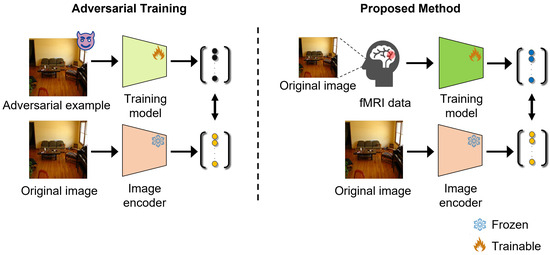
Figure 1.
Difference between general adversarial training and the proposed method. Although adversarial training generally uses adversarial examples and original images, the proposed method replaces adversarial examples with brain activity and uses brain activity and original images. The different colors of the training model indicate that the models have the same architecture but different input dimensions.
2. Related Work
In this section, we present related studies on CLIP and adversarial attacks to clarify the novelty and primary contribution of this study.
2.1. Contrastive Language–Image Pretraining
In conventional computer vision, supervised learning using human-defined labels has been the mainstream approach [20,21]. However, this approach has some challenges, such as the high cost of collecting large-scale labeled datasets and low generalizability to new classes. To address these challenges, this study proposes a method that leverages natural language to train vision models without relying on labeled datasets. Specifically, a dataset of 400 million (400 M) image–text pairs collected from the Internet is used to train an image encoder and a text encoder in a shared embedding space. Through contrastive learning, the cosine similarity between images and text is maximized, enabling the acquisition of a unified and generalizable embedding representation that integrates visual and language information.
Zero-shot classification refers to a task where a model classifies objects it has never seen during training. CLIP, which uses contrastive learning with a large amount of natural language data, enables general-purpose classification without relying on predefined labels. This technology allows CLIP to compare and understand images and text, facilitating applications in image retrieval, image generation, object detection, and various other fields that integrate visual and language information [22,23,24].
2.2. Adversarial Attacks
An adversarial attack is a type of attack that can be applied to machine learning models. This attack adds perturbations to the input sample to increase the error with the correct label and creates an example that causes the model to misclassify [25,26]. The types of attacks can be classified as white-box attacks [27,28,29] and black-box attacks [30,31,32].
In a white-box attack, the attacker has complete knowledge of the parameters, architecture, and gradient information of the target model and can perform a precisely designed attack. Thus, the success rate of the attack is high. However, in real-world scenarios, obtaining detailed information about a target model is difficult; thus, the practicality of white-box attacks is low. In contrast, a black-box attack is performed with only the target model’s output known. A black-box attack relies on gradient estimation and perturbation search; thus, its success rate is lower than that of a white-box attack. However, because it can be applied without knowing the details of the target model, its practicality is high.
3. Proposed Method
In this section, we explain the proposed adversarial defense method using brain activity. An overview of the proposed method is presented in Figure 2. The proposed method involves three steps. First, in Section 3.1, we describe how to create an augmented image set from the original image. Next, in Section 3.2, we explain how to extract and integrate features from both the augmented image set and brain activity data. Finally, in Section 3.3, we describe the training of the proposed method.
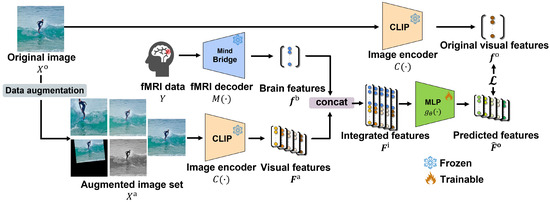
Figure 2.
Overview of the proposed method. We train the multilayer perceptron using brain activity features and predict robust features against adversarial attacks in the CLIP space by maximizing the cosine similarity between the predicted and original visual features. The difference in the color of the dots represents the difference in the output features for each input.
3.1. Creation of Augmented Image Set
To represent the characteristics of perturbations in adversarial examples without using the examples, we obtained diverse features from a single image. Specifically, we applied several data augmentation techniques to the original image . The types of data augmentation techniques were based on the transformations employed in SimCLR [33], which is a widely used SSL model. We used four types of augmentations. Specifically, we used “augmentation includes cropping, resizing, and flipping” and “augmentation includes rotation and horizontal translation” as spatial/geometric transformations of the data. In addition, we used “augmentation to grayscale” and “augmentation to put in Gaussian blur” as the appearance transformation of the data. We obtained the augmented image set consisting of the four images transformed using these data augmentations and the original image .
The above process yielded diverse features to represent the characteristics of perturbations in adversarial examples from only a single original image. In addition, it is expected to obtain a model that does not degrade accuracy for clean images, even for datasets containing brain activity for which a small amount of data are obtained.
3.2. Feature Extraction and Integration
To integrate the visual information from the augmented image set with the brain activity data, we first extracted features from each data. We used functional magnetic resonance imaging (fMRI) data Y of brain activity captured by fMRI [34] when the subjects viewed the original images . Specifically, we extracted visual features from the augmented image set and brain features from the fMRI data Y. Here, D represents the dimension in the CLIP space, and N represents the number of images in the augmented image set. In the proposed method, N is five, as described in Section 3.1. The visual features for the original and augmented images were extracted using the trained CLIP image encoder using the Vision Transformer (ViT-L/14) [2], and the brain features were extracted using an fMRI decoder . The fMRI decoder, specifically the MindBridge model [35], is designed to predict visual information related to the images viewed from the fMRI data, and it can embed these features in the CLIP space. The extracted features are obtained as follows:
For loss calculation, we integrated the extracted features. We concatenated the feature vectors of the augmented image set and the brain activity data to create the integrated features as follows:
The above process yielded integrated features for learning diverse characteristics from the data augmentation and invariant characteristics of the human brain. These features make the model robust against adversarial attacks without adversarial examples.
3.3. Training Process
We construct a three-layer multilayer perceptron (MLP) to predict the original visual features in the CLIP space using the integrated features described in Section 3.2. The parameters of the MLP were optimized by minimizing the loss to maximize the cosine similarity between the predicted features and the original visual features . The loss function is calculated as follows:
In the proposed method, we minimize the total loss by summing for all training original images.
Consequently, we constructed a CLIP feature embedding model that uses brain activity. The model embeds robust features against adversarial attacks. In addition, because the proposed method does not require adversarial examples, it is independent of attack type and does not degrade accuracy for clean images.
During testing, the integrated features, which combine the features extracted by CLIP from the test images and the corresponding brain visual features, were input to the trained MLP.
4. Experiments
4.1. Experimental Settings
4.1.1. Dataset
We used the natural scene dataset (NSD) [36] as the brain activity dataset. Figure 3 shows examples of the dataset. The NSD contains a pair of the original images collected from the MSCOCO dataset [37] and their corresponding fMRI data. We used 9841 samples from a single subject from the NSD, of which 8859 samples were training data and 982 samples were test data. This setting followed the procedure in a previous study [35].
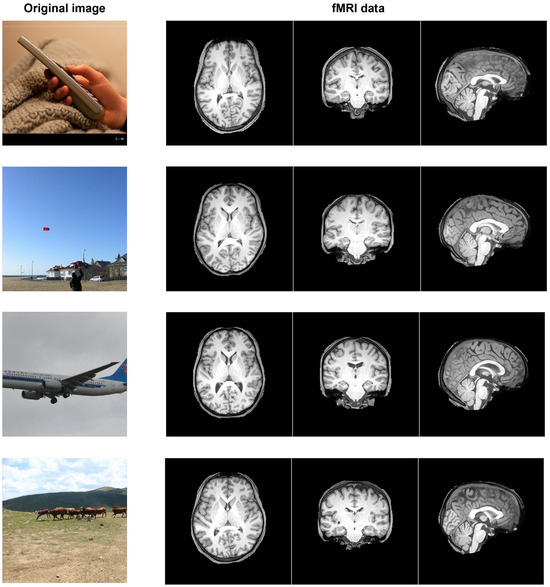
Figure 3.
Example of NSD. A paired dataset consisting of original images selected from the MSCOCO dataset and fMRI data capturing human brain activity while viewing those images.
4.1.2. Attack Settings
In this study, four types of gradient-based adversarial attacks were used to evaluate robustness against adversarial attacks, mitigate accuracy degradation for clean images, and reduce the dependence on the attack type. Conventional adversarial defense methods [38,39] typically evaluate performance using two or three types of adversarial attacks. Therefore, our evaluation using four types of attacks is reasonable. In particular, in addition to the commonly used FGSM-derived adversarial attacks PGD [27], APGD [28], and CW [29], we used the state-of-the-art attack method [40], which reduces the success rate of attacks but is generally attackable for any model. For each attack, the goal was to minimize the cosine similarity between the original image and the annotated caption in the CLIP space. The perturbation was applied with norms of and which are commonly used to evaluate adversarial robustness [10,12]. Here, represents the intensity of the perturbation.
4.1.3. Evaluation Details
To evaluate the effectiveness of the proposed method (PM), both quantitative and qualitative evaluations were conducted.
- Comparison Methods. To the best of our knowledge, no previous adversarial defense for the CLIP model requires neither adversarial examples nor degrades accuracy for clean images while being independent of attack types. Therefore, PM cannot be directly compared with other methods. In particular, several studies [41,42] that have considered new tasks do not adopt comparative methods; rather, they have conducted extensive experiments. Therefore, we also verified as many different perspectives as possible in the four comparison experiments. We used the following models:
- CLIPThis method involves the CLIP model with trained VIT-L/14. Adversarial examples are designed to deceive the model; thus, the output of this method indicates the success rate of the adversarial attack.
- PM w/o fMRIThis method involves the MLP model trained on only the augmented image set without fMRI data. By comparing this method with PM, we evaluated the effectiveness of brain activity.
- PM w/o fMRI with noiseThis method involves the MLP model trained on random noise data rather than fMRI data. This method represents the chance level, and by comparing brain activity with the chance level, we verified the significance of brain activity.
- RS:Randomized Smoothing [43]This method is a type of certified defense that mathematically guarantees that it can withstand all adversarial perturbations within a specific radius and basic defense method without adversarial examples for training. By comparing this method with PM, we show that PM is more effective than other defense methods that do not use adversarial examples.
- RSE:Random Self-Ensemble [44]This method is a type of ensemble smoothing that averages predicted results over multiple models or inputs. This method adds a random noise layer to the neural network and ensembles multiple predictions to improve robustness against adversarial attacks. We adopted it for the same reasons as RS.
- AT: Adversarial Training (ideal)This method involves the MLP model trained by adversarial training using each attack. AT (ideal) was trained with features extracted by the CLIP model from adversarial examples created using each attack against images in the training set. Note that “ideal” represents each attack to be used for the evaluation, and the obtained results correspond to the upper limit.
When using various adversarial attacks, we evaluated the robustness against adversarial attacks by comparing PM with PM w/o fMRI and PM w/o fMRI with noise. When using clean images, we evaluated the suppression of accuracy degradation by comparing PM with each AT.
- Evaluation via Image and Text Similarity. We evaluated similarity using two modalities to evaluate how closely the predicted features resembled the original visual features.
- Image similarityFor image similarity using evaluation, we input clean images and adversarial examples generated by various attacks into each comparison model. The cosine similarity between the predicted features and the original visual features extracted using the CLIP vision encoder was then calculated, and the average of each value for all test datasets S was computed. This analysis enables us to evaluate how brain activity influences image features. The equation is expressed as follows:
- Text similarityFor text similarity using evaluation, we computed the cosine similarity between the predicted features of each comparison model and the text features extracted from the caption corresponding to the original image using the CLIP text encoder and calculated the average of each value for all test datasets S. This analysis enables us to evaluate how brain activity influences the relationship between image and text features. The equation is expressed as follows:
- Evaluation via Image-to-Text Retrieval. To further evaluate the impact of the predicted features on the downstream tasks, we performed quantitative and qualitative evaluations using image-to-text retrieval [45]. In this task, when adversarial examples and clean images are input into each model, the model calculates the cosine similarity between the predicted features and those of the annotated captions in the NSD test set [36] in the CLIP space. Retrieval accuracy was evaluated quantitatively using rank and recall@k metrics.
- RankFor each test sample, we determined the ranking position at which the correct caption appeared in the search results and calculated the average of each ranking for all test datasets S. Rank ranges from 1 to S, and the closer it is to 1, the better the model is at placing the correct caption at a higher position. The equation is expressed as follows:
- Recall@kFor each test sample, we calculated the proportion of correct caption appearing within the top-k retrieved results and computed the average of each value for all test datasets S. Recall ranges from 0 to 1, and the closer it is to 1, the better the model is at selecting the correct caption within the top-k results. The equation is expressed as follows:
- In addition, for qualitative evaluation, we visualized the top-1 captions retrieved by each method when processing PGD, APGD, and CLEAN inputs. The motivation for employing this task is to effectively evaluate improvements against attacks that minimize the cosine similarity between the original image and the annotated caption.
4.1.4. Hypothesis Validation
In this experiment, we used the dataset [36], which contains only brain activity data in response to nonattacked images. This is based on the hypothesis that the changes in brain activity caused by adversarial perturbations are minimal, meaning that brain activity would be indistinguishable from that induced by nonattacked images. Figure 4 shows a clean image selected from the test dataset used in this experiment, along with various adversarial examples. All images appear identical; thus, they are confirmed to be indistinguishable. In addition, to support this finding, Table 1 shows the average peak signal-to-noise ratio (PSNR) and structural similarity index measure (SSIM), which are indices for evaluating the image quality of two images, calculated from the original images for the adversarial examples () generated by each attack in this experiment. The smaller the difference between two images, the closer the PSNR to infinity and the SSIM to one. According to a previous study [46], the PSNR and SSIM at which humans are unable to perceive changes in the image are greater than 40 dB and 0.985, respectively. Table 1 shows that all attacks satisfy the condition of being “imperceptible to the human eye’’. As decreases, the changes in the image reduces, and the PSNR and SSIM increase further. This finding supports the validity of our hypothesis and experimental setup.
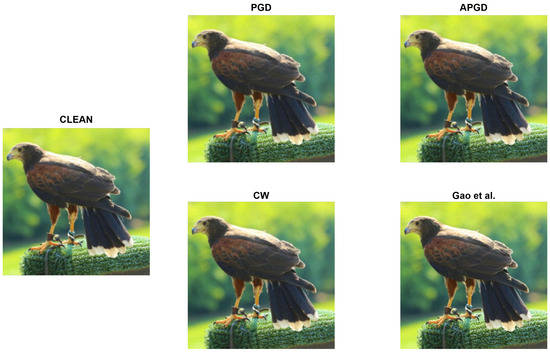
Figure 4.
Qualitative image comparison of clean images and various adversarial examples with perturbation of . This clean image is included in MSCOCO dataset [37]. The adversarial examples from each attack were created by ourselves [40].

Table 1.
Averages of PSNR and SSIM values between adversarial examples with created by each attack and the original images .
4.1.5. Ethical Considerations
The fMRI data used in our experiments are part of the publicly available NSD, which was collected under the approval of an Institutional Review Board (IRB) in the United States. Written informed consent was obtained from all participants, and the data have been anonymized and released in a format suitable for public research use. We exclusively use the anonymized voxel-level fMRI data provided by the NSD and do not access any personally identifiable information. When employing brain signals in the context of adversarial defense, both technical and ethical considerations must be taken into account with great care. In particular, the application of brain activity to improve the robustness of machine learning models is inspired by the inherent noise-resistant nature of human perceptual systems and is positioned within the broader context of socially and medically beneficial research. At the same time, recognizing the potential for misuse or ethical concerns associated with brain data, future studies must adhere strictly to established ethical guidelines and international standards for data protection.
4.2. Results and Discussion
To confirm the effectiveness of PM, we present the quantitative and qualitative comparison results.
4.2.1. Evaluation via Image and Text Similarity
- Quantitative Evaluation. Table 2 presents the image similarity results. PM approaches the upper limit compared with each method. PM reaches approximately 90% of the upper limit for each attack. In addition, when clean images are input, the cosine similarity of each AT is approximately 0.7 at most, whereas PM achieves a very high value of 0.973. Table 3 presents the text similarity results. Although the improvement is smaller than that of the image similarity, it reaches approximately 80% of the upper limit for each attack. In particular, for PGD and APGD with a perturbation of , the text similarity is close to the upper limit. When clean images are input, the cosine similarity of each AT is 0.099–0.238, and PM exhibits higher values than CLIP. In terms of both evaluation metrics, a comparison of PM and PM w/o fMRI demonstrates that introducing brain activity in PM is effective.
 Table 2. Evaluation of average cosine similarity between predicted and original visual features when several adversarial examples or clean images are input to each method. The results shown in the gray background represent the upper limits against each attack. In the evaluation using clean images, the results of AT (ideal) trained with PGD, APGD, and CW are shown from left to right.
Table 2. Evaluation of average cosine similarity between predicted and original visual features when several adversarial examples or clean images are input to each method. The results shown in the gray background represent the upper limits against each attack. In the evaluation using clean images, the results of AT (ideal) trained with PGD, APGD, and CW are shown from left to right. Table 3. Evaluation of average cosine similarity between predicted and text features.
Table 3. Evaluation of average cosine similarity between predicted and text features.
In addition, by comparing PM and PM w/o fMRI with noise, the effectiveness of introducing brain activity is confirmed. These results demonstrate that PM is robust against adversarial attacks and maintains its accuracy for clean images. By comparing PM and RS or RSE, the results are overwhelmingly superior for all adversarial examples used in the experiment and show that PM is more effective than other defense methods that do not use adversarial examples. Table 4 shows that both AT (PGD) and AT (Gao et al.) are robust only when the attack is used for training, whereas PM exhibits high cosine similarity for a different kind of attack. For example, at , AT (PGD) exhibits cosine similarity values of 0.889 against PGD but 0.745 against Gao et al. In addition, AT (Gao et al.) exhibits cosine similarity values of 0.921 against Gao et al. but 0.629 against PGD. However, PM maintains high cosine similarity values of 0.751 against PGD and 0.899 against Gao et al. As shown in Table 5, the text features exhibited a decrease in similarity for samples that were not used during adversarial training. At , a similar trend was observed for image similarity. These results demonstrate that PM can obtain robust features even against unknown adversarial attacks.

Table 4.
Evaluation of average cosine similarity between predicted and original visual features. We investigated the attack dependencies of adversarial defense methods against new attacks. The upper limit for each attack is shown in the gray background.

Table 5.
Evaluation of average cosine similarity between predicted and text features. We investigated the attack dependencies of adversarial defense methods against new attacks.
4.2.2. Evaluation via Image-to-Text Retrieval
- Quantitative Evaluation. Table 6 presents the quantitative results of image-to-text retrieval. First, for each adversarial attack, all methods improved the text retrieval results compared with CLIP. PM outperformed PM w/o fMRI and PM w/o fMRI with noise for all attacks. In addition, PM approached the upper limit represented by AT (ideal). Next, for clean images, PM outperformed AT, which was trained on each adversarial example. Furthermore, PM closely approached CLIP and performed at a similar level to PM w/o fMRI and PM w/o fMRI with noise; this result demonstrates that PM effectively mitigates accuracy degradation for clean images.
 Table 6. Quantitative results of image-to-text retrieval. AT (ideal) is the method of adversarial training using each attack used in the evaluation, and the results shown in the gray background represent the upper limits.
Table 6. Quantitative results of image-to-text retrieval. AT (ideal) is the method of adversarial training using each attack used in the evaluation, and the results shown in the gray background represent the upper limits. - Qualitative Evaluation. As shown in Figure 5, for the three types of attacks, PM succeeded in retrieving the correct caption for images for which the other comparison methods retrieved completely different results. In addition, PM exhibits successful retrieval in various scenes, not only in specific scenes. In some cases, as shown in Figure 6, PM retrieved captions that were semantically close, although it was not completely successful. Figure 7 presents the top-5 image-to-text retrieval results for PGD. In this figure, PM outputs the correct caption within the top-5 results. This indicates that the PM is able to adequately retain and extract the original semantic features from the brain activity data despite the image being perturbed by the adversarial attack. These results demonstrate that brain activity retains correct caption information and enables caption retrieval at a higher rank.
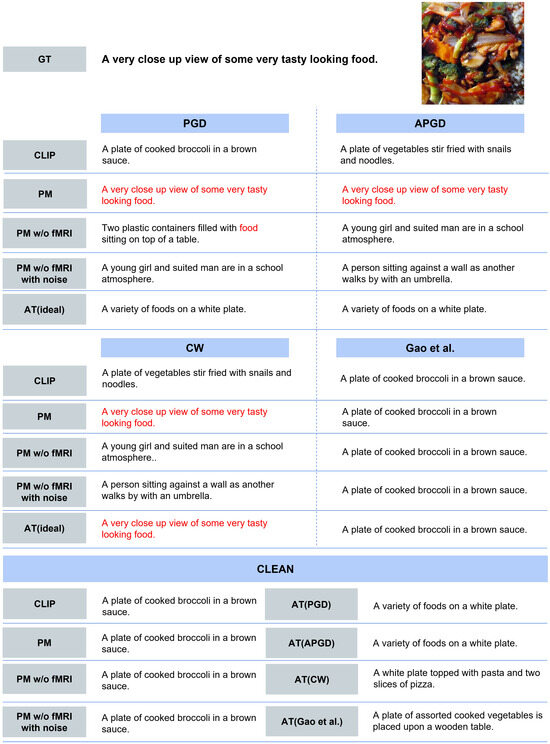 Figure 5. Qualitative evaluation of successful results. The top-1 image-to-text retrieval results when using the adversarial examples created by each attack are presented. Matching words from the ground truth (GT) are shown in red. This image used for this evaluation is included in MSCOCO dataset [37,40].
Figure 5. Qualitative evaluation of successful results. The top-1 image-to-text retrieval results when using the adversarial examples created by each attack are presented. Matching words from the ground truth (GT) are shown in red. This image used for this evaluation is included in MSCOCO dataset [37,40].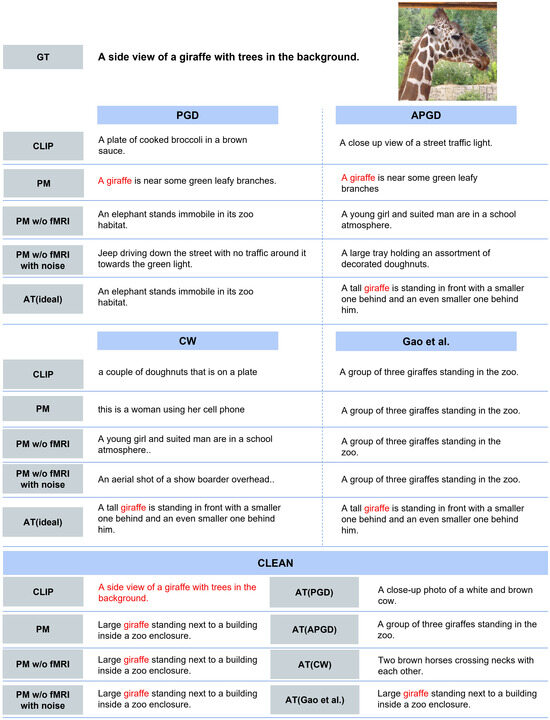 Figure 6. Qualitative evaluation of near-miss results. The top-1 image-to-text retrieval results when using the adversarial examples created by each attack are presented. Matching words from the GT are shown in red. This image used for this evaluation is included in MSCOCO dataset [37,40].
Figure 6. Qualitative evaluation of near-miss results. The top-1 image-to-text retrieval results when using the adversarial examples created by each attack are presented. Matching words from the GT are shown in red. This image used for this evaluation is included in MSCOCO dataset [37,40].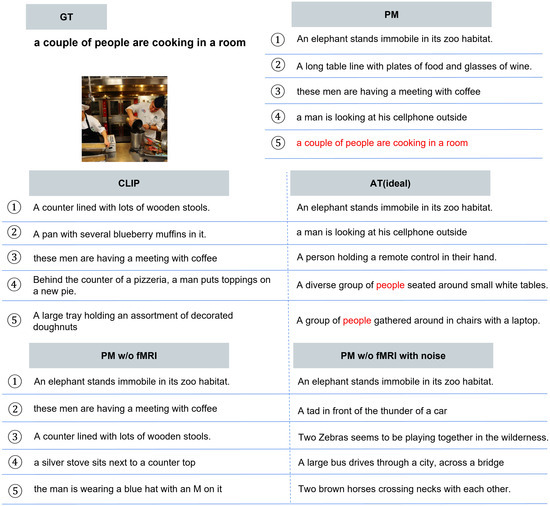 Figure 7. Qualitative evaluation of top-5 results. The top-5 image-to-text retrieval results when using the adversarial example created by PGD are presented. Matching words from the GT are shown in red. This image used for this evaluation is included in MSCOCO dataset [37].
Figure 7. Qualitative evaluation of top-5 results. The top-5 image-to-text retrieval results when using the adversarial example created by PGD are presented. Matching words from the GT are shown in red. This image used for this evaluation is included in MSCOCO dataset [37].
These evaluation results demonstrate that PM obtains features that are closer to those of the original image. Therefore, combining brain activity with data augmentation allows PM to obtain richer representations. PM achieves robust feature acquisition independent of adversarial attacks without degrading accuracy for clean images.
5. Conclusions
In this study, we have proposed an adversarial defense method using brain activity. The contribution of this paper is to demonstrate the effectiveness of brain activity against adversarial attacks against the CLIP model. Experimental results show that PM exhibited superior robustness to adversarial attacks. Furthermore, since PM does not require adversarial examples during training, PM shows excellent robustness not only against the common PGD attack but also against strong PGD-derived attacks and model-independent attacks. It is also found to maintain accuracy even for clean images. These results show that brain activity has robust semantic information and is effective against adversarial attacks. However, there are two challenges. The first is the impracticality of using fMRI data during inference. fMRI is expensive and has high physical costs. Therefore, it is difficult to use fMRI for inference because it is difficult to obtain frequently. The second is the limitation of the fMRI decoder used. MindBridge is personalized to individual brain signals, which makes it difficult to train easily when introducing new subjects and analyze because it is impossible to input each region of the brain. In future work, we are considering multimodal knowledge distillation, in which various brain activity data (fMRI, EEG, etc.) and images are trained in a single model, and weights are transferred so that inference is possible using only one modality (images only, EEG only, etc.). In addition, we are considering overcoming the problem of versatility and enabling analysis in each region of the brain by using a simple and accurate fMRI decoder, which has been actively studied in the reconstruction of visual stimuli. We are also considering creating our own empirical dataset by multisubject experiments that enable zero-shot classification, analyzing the robustness of brain activity in adversarial examples and clean images.
Author Contributions
Conceptualization, T.N., K.M., R.T., T.O., and M.H.; methodology, T.N, K.M., R.T., T.O., and M.H.; software, T.N.; validation, T.N., K.M., R.T., T.O., and M.H.; data curation, T.N.; writing—original draft preparation, T.N.; writing—review and editing, K.M., R.T., T.O., and M.H.; visualization, T.N.; funding acquisition, K.M., R.T., T.O., and M.H. All authors have read and agreed to the published version of the manuscript.
Funding
This work was partly supported by JSPS KAKENHI Grant Numbers JP24K02942 (Miki Haseyama), JP23K21676 (Takahiro Ogawa), JP23K11211 (Keisuke Maeda), and JP23K11141 (Ren Togo).
Institutional Review Board Statement
This study was conducted in accordance with the Declaration of Helsinki, and approved by the University of Minnesota institutional review board.
Informed Consent Statement
Informed written consent was obtained from all subjects involved in the study.
Data Availability Statement
Data are contained within the article.
Conflicts of Interest
The authors declare no conflicts of interest.
References
- Liu, H.; Li, C.; Li, Y.; Lee, Y.J. Improved baselines with visual instruction tuning. In Proceedings of the Conference on Computer Vision and Pattern Recognition, Seattle, WA, USA, 16–22 June 2024; pp. 26296–26306. [Google Scholar]
- Radford, A.; Kim, J.W.; Hallacy, C.; Ramesh, A.; Goh, G.; Agarwal, S.; Sastry, G.; Askell, A.; Mishkin, P.; Clark, J.; et al. Learning transferable visual models from natural language supervision. In Proceedings of the International Conference on Machine Learning, Virtual, 18–24 July 2021; pp. 8748–8763. [Google Scholar]
- Khan, A.; AlBarri, S.; Manzoor, M.A. Contrastive Self-Supervised Learning: A Survey on Different Architectures. In Proceedings of the International Conference on Artificial Intelligence, Xiamen, China, 23–25 September 2022; pp. 1–6. [Google Scholar]
- Goh, G.; Cammarata, N.; Voss, C.; Carter, S.; Petrov, M.; Schubert, L.; Radford, A.; Olah, C. Multimodal neurons in artificial neural networks. Distill 2021, 6, e30. [Google Scholar] [CrossRef]
- Wang, C.; Jia, R.; Liu, X.; Song, D. Benchmarking Zero-Shot Robustness of Multimodal Foundation Models: A Pilot Study. arXiv 2024, arXiv:2403.10499. [Google Scholar]
- Zhang, W.E.; Sheng, Q.Z.; Alhazmi, A.; Li, C. Adversarial attacks on deep-learning models in natural language processing: A survey. ACM Trans. Intell. Syst. Technol. 2020, 11, 1–41. [Google Scholar] [CrossRef]
- Novack, Z.; McAuley, J.; Lipton, Z.C.; Garg, S. Chils: Zero-shot image classification with hierarchical label sets. In Proceedings of the International Conference on Machine Learning, Honolulu, HI, USA, 23–29 July 2023; pp. 26342–26362. [Google Scholar]
- Ramesh, A.; Dhariwal, P.; Nichol, A.; Chu, C.; Chen, M. Hierarchical text-conditional image generation with clip latents. arXiv 2022, arXiv:2204.06125. [Google Scholar]
- Mokady, R.; Hertz, A.; Bermano, A.H. Clipcap: Clip prefix for image captioning. arXiv 2021, arXiv:2111.09734. [Google Scholar]
- Mao, C.; Geng, S.; Yang, J.; Wang, X.; Vondrick, C. Understanding zero-shot adversarial robustness for large-scale models. arXiv 2022, arXiv:2212.07016. [Google Scholar]
- Hendrycks, D.; Mazeika, M.; Kadavath, S.; Song, D. Using self-supervised learning can improve model robustness and uncertainty. In Proceedings of the Advances in Neural Information Processing Systems, Vancouver, BC, Canada, 8–14 December 2019; pp. 15663–15674. [Google Scholar]
- Schlarmann, C.; Singh, N.D.; Croce, F.; Hein, M. Robust CLIP: Unsupervised Adversarial Fine-Tuning of Vision Embeddings for Robust Large Vision-Language Models. In Proceedings of the International Conference on Machine Learning, Vienna, Austria, 21–27 July 2024; pp. 43685–43704. [Google Scholar]
- Kim, M.; Tack, J.; Hwang, S.J. Adversarial self-supervised contrastive learning. In Proceedings of the Advances in Neural Information Processing Systems, Virtual, 6–12 December 2020; pp. 2983–2994. [Google Scholar]
- Matsuo, E.; Kobayashi, I.; Nishimoto, S.; Nishida, S.; Asoh, H. Describing semantic representations of brain activity evoked by visual stimuli. In Proceedings of the IEEE International Conference on Systems, Man, and Cybernetics, Miyazaki, Japan, 7–10 October 2018; pp. 576–583. [Google Scholar]
- Zhang, Y.; Tian, M.; Liu, B. An action decoding framework combined with deep neural network for predicting the semantics of human actions in videos from evoked brain activities. Front. Neuroinform. 2025, 19, 1526259. [Google Scholar] [CrossRef] [PubMed]
- Zhao, M.; Liu, B. An fMRI-based auditory decoding framework combined with convolutional neural network for predicting the semantics of real-life sounds from brain activity. Appl. Intell. 2025, 55, 118. [Google Scholar] [CrossRef]
- Posner, M.I.; Petersen, S.E. The attention system of the human brain. Annu. Rev. Neurosci. 1990, 13, 25–42. [Google Scholar] [CrossRef] [PubMed]
- Ross, A.; Jain, A.K. Human recognition using biometrics: An overview. Ann. Telecommun. 2007, 62, 11–35. [Google Scholar] [CrossRef]
- Rakhimberdina, Z.; Liu, X.; Murata, T. Strengthening robustness under adversarial attacks using brain visual codes. IEEE Access 2022, 10, 96149–96158. [Google Scholar] [CrossRef]
- Gupta, V.; Mishra, V.K.; Singhal, P.; Kumar, A. An Overview of Supervised Machine Learning Algorithm. In Proceedings of the International Conference on System Modeling & Advancement in Research Trends, Moradabad, India, 16–17 December 2022; pp. 87–92. [Google Scholar]
- O’Mahony, N.; Campbell, S.; Carvalho, A.; Harapanahalli, S.; Hernandez, G.V.; Krpalkova, L.; Riordan, D.; Walsh, J. Deep learning vs. traditional computer vision. In Proceedings of the the Computer Vision Conference, Glasgow, UK, 23–28 August 2020; pp. 128–144. [Google Scholar]
- Baldrati, A.; Bertini, M.; Uricchio, T.; Del Bimbo, A. Effective Conditioned and Composed Image Retrieval Combining CLIP-Based Features. In Proceedings of the the IEEE/CVF Conference on Computer Vision and Pattern Recognition, New Orleans, LA, USA, 18–24 June 2022; pp. 21466–21474. [Google Scholar]
- Ramesh, A.; Pavlov, M.; Goh, G.; Gray, S.; Voss, C.; Radford, A.; Chen, M.; Sutskever, I. Zero-shot text-to-image generation. In Proceedings of the International Conference on Machine Learning, Virtual, 18–24 July 2021; pp. 8821–8831. [Google Scholar]
- Lin, J.; Gong, S. Gridclip: One-stage object detection by grid-level clip representation learning. arXiv 2023, arXiv:2303.09252. [Google Scholar]
- Chakraborty, A.; Alam, M.; Dey, V.; Chattopadhyay, A.; Mukhopadhyay, D. A survey on adversarial attacks and defences. CAAI Trans. Intell. Technol. 2021, 6, 25–45. [Google Scholar] [CrossRef]
- Ren, K.; Zheng, T.; Qin, Z.; Liu, X. Adversarial attacks and defenses in deep learning. Engineering 2020, 6, 346–360. [Google Scholar] [CrossRef]
- Madry, A.; Makelov, A.; Schmidt, L.; Tsipras, D.; Vladu, A. Towards deep learning models resistant to adversarial attacks. arXiv 2017, arXiv:1706.06083. [Google Scholar]
- Croce, F.; Hein, M. Reliable evaluation of adversarial robustness with an ensemble of diverse parameter-free attacks. In Proceedings of the International Conference on Machine Learning, Virtual, 13–18 July 2020; pp. 2206–2216. [Google Scholar]
- Carlini, N.; Wagner, D. Towards evaluating the robustness of neural networks. In Proceedings of the IEEE Symposium on Security and Privacy, San Jose, CA, USA, 22–26 May 2017; pp. 39–57. [Google Scholar]
- Guo, C.; Gardner, J.; You, Y.; Wilson, A.G.; Weinberger, K. Simple black-box adversarial attacks. In Proceedings of the International Conference on Machine Learning, Long Beach, CA, USA, 9–15 June 2019; pp. 2484–2493. [Google Scholar]
- Ilyas, A.; Engstrom, L.; Athalye, A.; Lin, J. Black-box adversarial attacks with limited queries and information. In Proceedings of the International Conference on Machine Learning, Stockholm, Sweden, 10–15 July 2018; pp. 2137–2146. [Google Scholar]
- Jiang, L.; Ma, X.; Chen, S.; Bailey, J.; Jiang, Y.G. Black-box adversarial attacks on video recognition models. In Proceedings of the the ACM International Conference on Multimedia, Nice, France, 21–25 October 2019; pp. 864–872. [Google Scholar]
- Chen, T.; Kornblith, S.; Norouzi, M.; Hinton, G. A simple framework for contrastive learning of visual representations. In Proceedings of the International Conference on Machine Learning, Virtual, 13–18 July 2020; pp. 1597–1607. [Google Scholar]
- Glover, G.H. Overview of functional magnetic resonance imaging. Neurosurg. Clin. 2011, 22, 133–139. [Google Scholar] [CrossRef] [PubMed]
- Wang, S.; Liu, S.; Tan, Z.; Wang, X. Mindbridge: A cross-subject brain decoding framework. In Proceedings of the Conference on Computer Vision and Pattern Recognition, Seattle, WA, USA, 17–18 June 2024; pp. 11333–11342. [Google Scholar]
- Allen, E.J.; St-Yves, G.; Wu, Y.; Breedlove, J.L.; Prince, J.S.; Dowdle, L.T.; Nau, M.; Caron, B.; Pestilli, F.; Charest, I.; et al. A massive 7T fMRI dataset to bridge cognitive neuroscience and artificial intelligence. Nat. Neurosci. 2022, 25, 116–126. [Google Scholar] [CrossRef] [PubMed]
- Lin, T.Y.; Maire, M.; Belongie, S.; Hays, J.; Perona, P.; Ramanan, D.; Dollár, P.; Zitnick, C.L. Microsoft COCO: Common Objects in Context. In Proceedings of the European Conference on Computer Vision, Zurich, Switzerland, 6–12 September 2014; pp. 740–755. [Google Scholar]
- Chen, T.; Liu, S.; Chang, S.; Cheng, Y.; Amini, L.; Wang, Z. Adversarial robustness: From self-supervised pre-training to fine-tuning. In Proceedings of the Conference on Computer Vision and Pattern Recognition, Seattle, WA, USA, 13–19 June 2020; pp. 699–708. [Google Scholar]
- Dong, J.; Moosavi-Dezfooli, S.M.; Lai, J.; Xie, X. The enemy of my enemy is my friend: Exploring inverse adversaries for improving adversarial training. In Proceedings of the Conference on Computer Vision and Pattern Recognition, Vancouver, BC, Canada, 17–24 June 2023; pp. 24678–24687. [Google Scholar]
- Gao, S.; Jia, X.; Ren, X.; Tsang, I.; Guo, Q. Boosting Transferability in Vision-Language Attacks via Diversification along the Intersection Region of Adversarial Trajectory. arXiv 2024, arXiv:2403.12445. [Google Scholar]
- Horikawa, T.; Kamitani, Y. Generic decoding of seen and imagined objects using hierarchical visual features. Nat. Commun. 2017, 8, 15037. [Google Scholar] [CrossRef] [PubMed]
- Takagi, Y.; Nishimoto, S. High-resolution image reconstruction with latent diffusion models from human brain activity. In Proceedings of the Conference on Computer Vision and Pattern Recognition, Vancouver, BC, Canada, 17–24 June 2023; pp. 14453–14463. [Google Scholar]
- Cohen, J.; Rosenfeld, E.; Kolter, Z. Certified adversarial robustness via randomized smoothing. In Proceedings of the International Conference on Machine Learning, Beijing, China, 8–11 November 2019; pp. 1310–1320. [Google Scholar]
- Liu, X.; Cheng, M.; Zhang, H.; Hsieh, C.J. Towards robust neural networks via random self-ensemble. In Proceedings of the European Conference on Computer Vision, Munich, Germany, 8–14 September 2018; pp. 369–385. [Google Scholar]
- Lu, D.; Wang, Z.; Wang, T.; Guan, W.; Gao, H.; Zheng, F. Set-level Guidance Attack: Boosting Adversarial Transferability of Vision-Language Pre-training Models. In Proceedings of the International Conference on Computer Vision, Chenzhou, China, 25–28 August 2023; pp. 102–111. [Google Scholar]
- Ponomarenko, N.; Zemliachenko, A.; Lukin, V.; Egiazarian, K.; Astola, J. Image lossy compression providing a required visual quality. In Proceedings of the Workshop on Video Processing and Quality Metrics for Consumer Electronics, Scottsdale, AZ, USA, 15 June 2013; pp. 17–21. [Google Scholar]
Disclaimer/Publisher’s Note: The statements, opinions and data contained in all publications are solely those of the individual author(s) and contributor(s) and not of MDPI and/or the editor(s). MDPI and/or the editor(s) disclaim responsibility for any injury to people or property resulting from any ideas, methods, instructions or products referred to in the content. |
© 2025 by the authors. Licensee MDPI, Basel, Switzerland. This article is an open access article distributed under the terms and conditions of the Creative Commons Attribution (CC BY) license (https://creativecommons.org/licenses/by/4.0/).